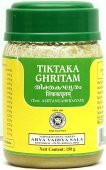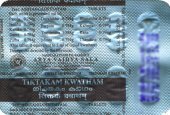Duralabha, Durālabhā: 13 definitions
Introduction:
Duralabha means something in Buddhism, Pali, Hinduism, Sanskrit, biology. If you want to know the exact meaning, history, etymology or English translation of this term then check out the descriptions on this page. Add your comment or reference to a book if you want to contribute to this summary article.
In Hinduism
Ayurveda (science of life)
Cikitsa (natural therapy and treatment for medical conditions)
Source: Wisdom Library: Ayurveda: Cikitsa1) Durālabhā (दुरालभा, “difficult to be handled ”) is a Sanskrit word referring to the “climbing nettle plant”, a herb from the Euphorbiaceae (spurge) family of plants, and is used throughout Ayurvedic literature such as the Caraka-saṃhitā. It is also known by the name Duḥsparśā, and in Hindi it is known as Barhantā. The official botanical name of the plant is Tragia involucrata and in English it is commonly known as “Indian stinging nettle” among others. The compound Durālabha is composed of the prefix Duḥ and the word Ālabha (‘touching , grasping’), which in turn is composed of the prefix Ā and Labha (‘obtain’)
2) Durālabha (दुरालभ):—Another name for Dhanvayavāsa, a medicinal plant (Alhagi maurorum/camelorum) used in the treatment of fever (jvara), as described in the Jvaracikitsā (or “the treatment of fever”) which is part of the 7th-century Mādhavacikitsā, a Sanskrit classical work on Āyurveda. In this work, the plant is mentioned being part of the Bṛhatyādigaṇa group of medicinal drugs.
Nighantu (Synonyms and Characteristics of Drugs and technical terms)
Source: WorldCat: Rāj nighaṇṭuDurālabhā (दुरालभा) is another name for Dhanvayāsa, an unidentified medicinal plant, according to verse 4.53-55 of the 13th-century Raj Nighantu or Rājanighaṇṭu. The fourth chapter (śatāhvādi-varga) of this book enumerates eighty varieties of small plants (pṛthu-kṣupa). Together with the names Durālabhā and Dhanvayāsa, there are a total of fourteen Sanskrit synonyms identified for this plant.
Kalpa (Formulas, Drug prescriptions and other Medicinal preparations)
Source: Shodhganga: Edition translation and critical study of yogasarasamgrahaDurālabhā (दुरालभा) refers to the medicinal plant known as “Tragia involucrata Linn.” and is dealt with in the 15th-century Yogasārasaṅgraha (Yogasara-saṅgraha) by Vāsudeva: an unpublished Keralite work representing an Ayurvedic compendium of medicinal recipes. The Yogasārasaṃgraha [mentioning durālabhā] deals with entire recipes in the route of administration, and thus deals with the knowledge of pharmacy (bhaiṣajya-kalpanā) which is a branch of pharmacology (dravyaguṇa).

Āyurveda (आयुर्वेद, ayurveda) is a branch of Indian science dealing with medicine, herbalism, taxology, anatomy, surgery, alchemy and related topics. Traditional practice of Āyurveda in ancient India dates back to at least the first millenium BC. Literature is commonly written in Sanskrit using various poetic metres.
In Buddhism
Tibetan Buddhism (Vajrayana or tantric Buddhism)
Source: Wisdom Library: Tibetan BuddhismDurālabha (दुरालभ) is the name of a Tathāgata (Buddha) mentioned as attending the teachings in the 6th century Mañjuśrīmūlakalpa: one of the largest Kriyā Tantras devoted to Mañjuśrī (the Bodhisattva of wisdom) representing an encyclopedia of knowledge primarily concerned with ritualistic elements in Buddhism. The teachings in this text originate from Mañjuśrī and were taught to and by Buddha Śākyamuni in the presence of a large audience (including Durālabha).

Tibetan Buddhism includes schools such as Nyingma, Kadampa, Kagyu and Gelug. Their primary canon of literature is divided in two broad categories: The Kangyur, which consists of Buddha’s words, and the Tengyur, which includes commentaries from various sources. Esotericism and tantra techniques (vajrayāna) are collected indepently.
Biology (plants and animals)
Source: Wisdom Library: Local Names of Plants and DrugsDuralabha in the Sanskrit language is the name of a plant identified with Alhagi maurorum Medik. from the Fabaceae (Pea) family having the following synonyms: Alhagi pseudalhagi, Alhagi camelorum, Alhagi persarum. For the possible medicinal usage of duralabha, you can check this page for potential sources and references, although be aware that any some or none of the side-effects may not be mentioned here, wether they be harmful or beneficial to health.
Source: Google Books: CRC World Dictionary (Regional names)1) Duralabha in India is the name of a plant defined with Alhagi maurorum in various botanical sources. This page contains potential references in Ayurveda, modern medicine, and other folk traditions or local practices It has the synonym Hedysarum alhagi L. (among others).
2) Duralabha is also identified with Alhagi pseudalhagi It has the synonym Alhagi pseudalhagi (M. Bieb.) Desv. (etc.).
3) Duralabha is also identified with Fagonia arabica.
4) Duralabha is also identified with Fagonia cretica It has the synonym Fagonia desertorum Andr..
5) Duralabha is also identified with Fagonia indica It has the synonym Fagonia mysorensis Roth (etc.).
6) Duralabha is also identified with Heliotropium indicum It has the synonym Eliopia riparia Raf. (etc.).
7) Duralabha is also identified with Tragia involucrata It has the synonym Croton urens L. (etc.).
Example references for further research on medicinal uses or toxicity (see latin names for full list):
· Biodiversidad del estado de Tabasco (2005)
· Museo Nacional de Historia Natural (Bolivia) Comunicación (1990)
· Diagn. Pl. Orient. (1843)
· The Gardeners Dictionary (1768)
· Regnum Vegetabile, or ‘a Series of Handbooks for the Use of Plant Taxonomists and Plant Geographers’ (1993)
· Bulletin de la Société Botanique de France (1900)
If you are looking for specific details regarding Duralabha, for example chemical composition, pregnancy safety, extract dosage, health benefits, side effects, diet and recipes, have a look at these references.

This sections includes definitions from the five kingdoms of living things: Animals, Plants, Fungi, Protists and Monera. It will include both the official binomial nomenclature (scientific names usually in Latin) as well as regional spellings and variants.
Languages of India and abroad
Sanskrit dictionary
Source: Cologne Digital Sanskrit Dictionaries: Shabda-Sagara Sanskrit-English DictionaryDurālabha (दुरालभ).—mfn.
(-bhaḥ-bhā-bhaṃ) 1. Unfit to be touched or taken, difficult of handling. 2. Difficult of attainment. f.
(-bhā) A prickly plant, commonly Jawasa, (Hedysarum alhagi.) E. dur bad, hardly, labh to attain, with āṅ prefixed, affix khala, fem. affix ṭāp: see the next.
--- OR ---
Durālabhā (दुरालभा).—f.
(-bhā) A prickly nightshade. E. dur difficult, labh to gain, affix khal but without any nasal.
Source: Cologne Digital Sanskrit Dictionaries: Cappeller Sanskrit-English DictionaryDurālabha (दुरालभ).—[adjective] difficult to be laid hold of.
Source: Cologne Digital Sanskrit Dictionaries: Monier-Williams Sanskrit-English Dictionary1) Durālabha (दुरालभ):—[=dur-ālabha] [from dur] mfn. difficult to be handled, [Horace H. Wilson]
2) [v.s. ...] ā, (f.) Alhagi Maurorum, [Suśruta]
Source: Cologne Digital Sanskrit Dictionaries: Yates Sanskrit-English DictionaryDurālabha (दुरालभ):—[durā+labha] (bhaḥ-bhā-bhaṃ) a. Unfit to be handled. f. A prickly plant (Hedysarum alhagi).
[Sanskrit to German]
Sanskrit, also spelled संस्कृतम् (saṃskṛtam), is an ancient language of India commonly seen as the grandmother of the Indo-European language family (even English!). Closely allied with Prakrit and Pali, Sanskrit is more exhaustive in both grammar and terms and has the most extensive collection of literature in the world, greatly surpassing its sister-languages Greek and Latin.
Kannada-English dictionary
Source: Alar: Kannada-English corpusDurālabha (ದುರಾಲಭ):—[noun] = ದುರಾಲಭೆ [duralabhe].
--- OR ---
Durālabha (ದುರಾಲಭ):—
1) [adjective] that cannot be handled or managed.
2) [adjective] that is unfit to be touched.
3) [adjective] that is difficult to get or attain.
Kannada is a Dravidian language (as opposed to the Indo-European language family) mainly spoken in the southwestern region of India.
See also (Relevant definitions)
Starts with: Duralabhadi.
Ends with: Kshudraduralabha.
Full-text (+6): Duralambha, Alabha, Atmamuli, Padmamukhi, Phanihrit, Idamkarya, Sukshmapattraka, Phanjika, Kshudraduralabha, Ajadani, Turalapam, Dhanvayasa, Dusparshaka, Dusprik, Tuva, Kotittuva, Yavasa, Kasahara, Dushpradharsha, Dhanvayavasa.
Relevant text
Search found 11 books and stories containing Duralabha, Durālabhā, Durālabha, Dur-alabha, Dur-ālabha; (plurals include: Duralabhas, Durālabhās, Durālabhas, alabhas, ālabhas). You can also click to the full overview containing English textual excerpts. Below are direct links for the most relevant articles:
Rasa Jala Nidhi, vol 3: Metals, Gems and other substances (by Bhudeb Mookerjee)
Part 3 - Alkaline substance (3): Svarji-kshara (refined natron) < [Chapter XXVIII - Kshara (akalis)]
Rasa Jala Nidhi, vol 5: Treatment of various afflictions (by Bhudeb Mookerjee)
Chapter 23 - Bhrama (vertigo), Nidra (sleeping disease), and Tandra (drowsiness)
Chapter 1 - Symptoms and treatment of Raktapitta (Hemoptysis)
Chapter 13 - Symptoms and treatment of Pandu (anemia) and Kamala (jaundice)
The Garuda Purana (by Manmatha Nath Dutt)
Chapter CXCVIII - Various medicinal compounds disclosed by Hari to Hara < [Dhanvantari Samhita]
Chapter CCI - Various other medicinal Recipes (continued) < [Dhanvantari Samhita]
Chapter CCXXVII - Different names of the Ayurvedic Drugs < [Dhanvantari Samhita]
Amarakoshodghatana of Kshirasvamin (study) (by A. Yamuna Devi)
Flora (7): Shrubs < [Chapter 5 - Aspects of Nature]
Rasa Jala Nidhi, vol 4: Iatrochemistry (by Bhudeb Mookerjee)
Treatment for fever (139): Shlesma-shailendra rasa < [Chapter II - Fever (jvara)]
Part 51 - Treatment for chronic diarrhea (23): Grahani-gaja-keshari rasa < [Chapter III - Jvaratisara fever with diarrhoea]
Sushruta Samhita, Volume 6: Uttara-tantra (by Kaviraj Kunja Lal Bhishagratna)
Chapter XXIX - Therapeutics of an attack by Skandapasmara < [Canto II - Kaumarabhritya-tantra (pediatrics, gynecology and pregnancy)]
Chapter LII - Symptoms and Treatment of Cough (Kasa) < [Canto III - Kaya-chikitsa-tantra (internal medicine)]
Chapter LI - Symptoms and Treatment of Asthma (Shvasa) < [Canto III - Kaya-chikitsa-tantra (internal medicine)]
Related products
(+2 more products available)





